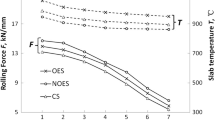Abstract
Two types of wear-resistant, heavy-duty rolls are widely used in high carbon steel strip cold rolling: high-speed steel (HSS) rolls and chromium-electroplated rolls. Lower costs and replacement of chromium, criticized because of its effects on health, are two reasons to look for another coating solution for rolling mill rolls. To be economically viable, it must maintain surface quality in accordance with customer requirements, and/or allow larger strip reduction per pass, and/or work at higher rolling speed, and/or resist wear better so as to roll more coils between roll changes. Different phenomena, strongly related to the nature of roll surface, must be controlled in order to benefit from such improvements: severe adhesive wear of strip and adhesive transfer (“pick up,” “roll coating”), as well as abrasive wear of rolls. DLC coatings are widely used in various tribological applications. Their resistance to wear and adhesion gives them a high potential in rolling. The interest of a hydrogenated DLC coating (here, with 20 at.% H) has therefore been studied for this application. The proposed paper analyzes its tribological and mechanical characteristics under conditions relevant to rolling processes, using two well adapted tests. Its resistance to transfer, severe adhesive wear, abrasive wear, and fatigue is evaluated and compared not only with reference materials used in the rolling industry, uncoated, and chrome-coated HSS, but also with other PVD coatings (TiN, CrN, TiBN) already described in previous papers. The results show the good potential of this coating in this application.













Similar content being viewed by others
References
Montmitonnet P, Delamare F, Rizoulières B (2000) Transfer layer and friction in cold metal strip rolling processes. Wear 245:125–135
Paustenbach D, Finley B, Mowat F, Kerger B (2003) Human health risk and exposure assessment of chromium (VI) in tap water. J Tox Envir Health 66(17):1295–1339
Navinšek B, Panjan P, Milošev I (1999) PVD coatings as an environmentally clean alternative to electroplating and electroless processes. Surf Coatings Tech 116–119:476–487
Van Stappen M, Stals LM, Kerkhofs M, Quaeyhaegens C (1995) State of the art for the industrial use of ceramic PVD coatings. Surf Coat Techn 74–75:629–633
Prengel HG, Jindal PC, Wendt KH, Santhanam AT, Hedge PL, Penich RM (2001) A new class of high performance PVD coatings on cemented carbide cutting tools. Surf Coat Techn 139:25–34
Mandibide C (2003) Caractérisation des revêtements PVD à base de nitrures de métaux de transition pour application mécanique (Characterization of transition metals nitride based coatings for mechanical applications), Ph.D. Dissertation, INSA Lyon (in French)
Zhang ZG (2008) Elaboration de dépôts nano-composés par pulvérisation cathodique magnétron pour la substitution du chrome électrolytique (Elaboration of nanostructured coatings by Magnetron Cathodic Sputtering as substitutes of electrolytic Cr), Ph.D. Dissertation, UTBM (in French)
Azushima A, Morita Y (1992) Lubrication characteristics of surface treated rolls. ISIJ Int 32:1232–1237
Jimbo Y, Azushima A (2001) Lubrication characteristics of physical vapor deposition TiN-coated roll for high productivity in cold rolling of low-carbon steel sheet. Wear 249:215–221
Ould C, Badiche X, Montmitonnet P, Gachon Y (2013) PVD coatings for mill rolls for cold rolling of high carbon steel strips – laboratory tests. Wear 306(1–2):103–112
Ould C, Badiche X, Montmitonnet P, Gachon Y (2013) PVD coated mill rolls for cold rolling of stainless steel strips: tribological and mechanical laboratory tests. J Manuf Process 15:77–86
Donnet C, Erdemir A (2008) Tribology of diamond-like carbon films; fundamentals and applications. Springer, New York
Erdemir A, Donnet C (2006) Tribology of diamond-like carbon films: recent progress and future prospects - topical review. J Phys D Appl Phys 39:R311–R327
Robertson J (2002) Diamond-like amorphous carbon. Mater Sci Eng R37:129–281
Erdemir A, Martin JM (2018) Superior wear resistance of diamond and DLC coatings. Curr Opin Solid State Mater Sci 22(6):243–254
Kalin M, Velkavrh I, Vižintin J, Ožbolt L (2008) Review of boundary lubrication mechanisms of DLC coatings used in mechanical applications. Meccanica 43:623–637
dos Santos de Almeida EA, Milan JCG, da Costa CE, Binder C, de Mello JDB, Costa HL (2021) Combined use of surface texturing, plasma nitriding and DLC coating on tool steel. Coatings 11(2):201
Héau C, Ould C, Maurin-Perrier P (2013) Tribological behaviour analysis of hydrogenated and non-hydrogenated DLC lubricated by oils with and without additives. Lubr Sci 25(4):275–285
Fuß HG, Frank M, (2008). Industrial production of DLC coatings. In: Tribology of diamond-like carbon films: fundamentals and applications. C Donnet, A Erdemir (eds.) Published by Springer Science + Business Media, LLC, New York, USA, pp 457–468
Acknowledgements
They thank the partners HEF R&D, Constellium CRV, and Paturle Aciers for technical discussions and authorization to present this work.
Funding
The French Ministry of Industry, the Rhone-Alpes Region, the Conseil Général of the Loire Departement, and Saint-Etienne Metropole authority provided funding for the DURACYL Project.
Author information
Authors and Affiliations
Corresponding author
Ethics declarations
Conflict of interest
The authors declare no competing interests.
Additional information
Publisher's Note
Springer Nature remains neutral with regard to jurisdictional claims in published maps and institutional affiliations.
Rights and permissions
Springer Nature or its licensor (e.g. a society or other partner) holds exclusive rights to this article under a publishing agreement with the author(s) or other rightsholder(s); author self-archiving of the accepted manuscript version of this article is solely governed by the terms of such publishing agreement and applicable law.
About this article
Cite this article
Ould, C., Gachon, Y., Badiche, X. et al. Tribological and mechanical laboratory analysis of DLC as substitutes for hard chromium coating in view of cold rolling of high carbon steel strips. Int J Adv Manuf Technol 129, 5435–5446 (2023). https://doi.org/10.1007/s00170-023-12664-8
Received:
Accepted:
Published:
Issue Date:
DOI: https://doi.org/10.1007/s00170-023-12664-8




